What are the basics of COVID-19?
In this article we will describe the basics about COVID-19.

1. What is SARS-CoV-2?
Severe acute respiratory syndrome coronavirus 2 (SARS-CoV-2) is a novel coronavirus that first appeared in Wuhan, China in 2019. SARS-CoV-2 is a new strain of coronavirus that had not been identified in humans before.
2. What is COVID-19?
Coronavirus disease 2019 (COVID-19) is the respiratory disease caused by SARS-CoV-2.
What does ‘COVID’ stand for?
‘CO’ stands for corona, ‘VI’ for virus, and ‘D’ for disease.
3. Where do coronaviruses come from?
Coronaviruses can infect and circulate among different animal species, such as pigs, cats and dogs.
Some groups of coronaviruses also circulate among humans and cause seasonal epidemics, mostly during the winter months.
Bats are also natural hosts of these viruses (including COVID-19) and have been the source of coronaviruses that have transmitted to humans and caused severe disease.
The precise way in which SARS-CoV-2 is transmitted from animals to humans is currently unknown.
4. What are the basics about COVID-19 infection?
The symptoms of COVID-19 typically appear between 2 and 14 days after exposure and are similar to symptoms of:
- Other coronavirus strains, which often affect the respiratory system
- Many other viruses – e.g. rhinoviruses or influenza viruses – that cause the common cold or flu.
Most infections are mild and last 5-6 days, and people are fully better by 2 weeks. So you do not normally need to see a doctor.
Also it’s important to note that 30% of people with COVID-19 have no symptoms at all, or report only very mild symptoms.
What is the mortality of COVID-19?
About 1%. But it is very variable according to age – from 15% if 80 years old or over, to minimal if under 10 years.
5. What are the symptoms of COVID-19?
Most COVID-19 symptoms are similar to those of the flu, the common cold and other conditions, so a test is required to confirm if someone has COVID-19.
The most common symptoms are fever, cough, sore throat, congestion or runny nose, and tiredness.
Other symptoms can include shortness of breath, chest pain, muscle or body aches, headache, loss of taste or smell, confusion, diarrhoea, nausea and vomiting, abdominal pain, and skin rashes. In addition to these symptoms, infants may have difficulty feeding.
Children of any age can become ill with COVID-19. Whilst children and adults experience similar symptoms, children generally have less serious illness than adults.
Summary
We have described what are the basics of COVID-19. We hope it has been helpful.
Other resources
What does a positive COVID-19 test look like?
Questions and answers about COVID-19
What is the mortality of COVID-19?
When should you see a doctor about COVID-19?
UK government advice on COVID-19
Further UK government advice on COVID-19
Last Reviewed on 28 May 2024
